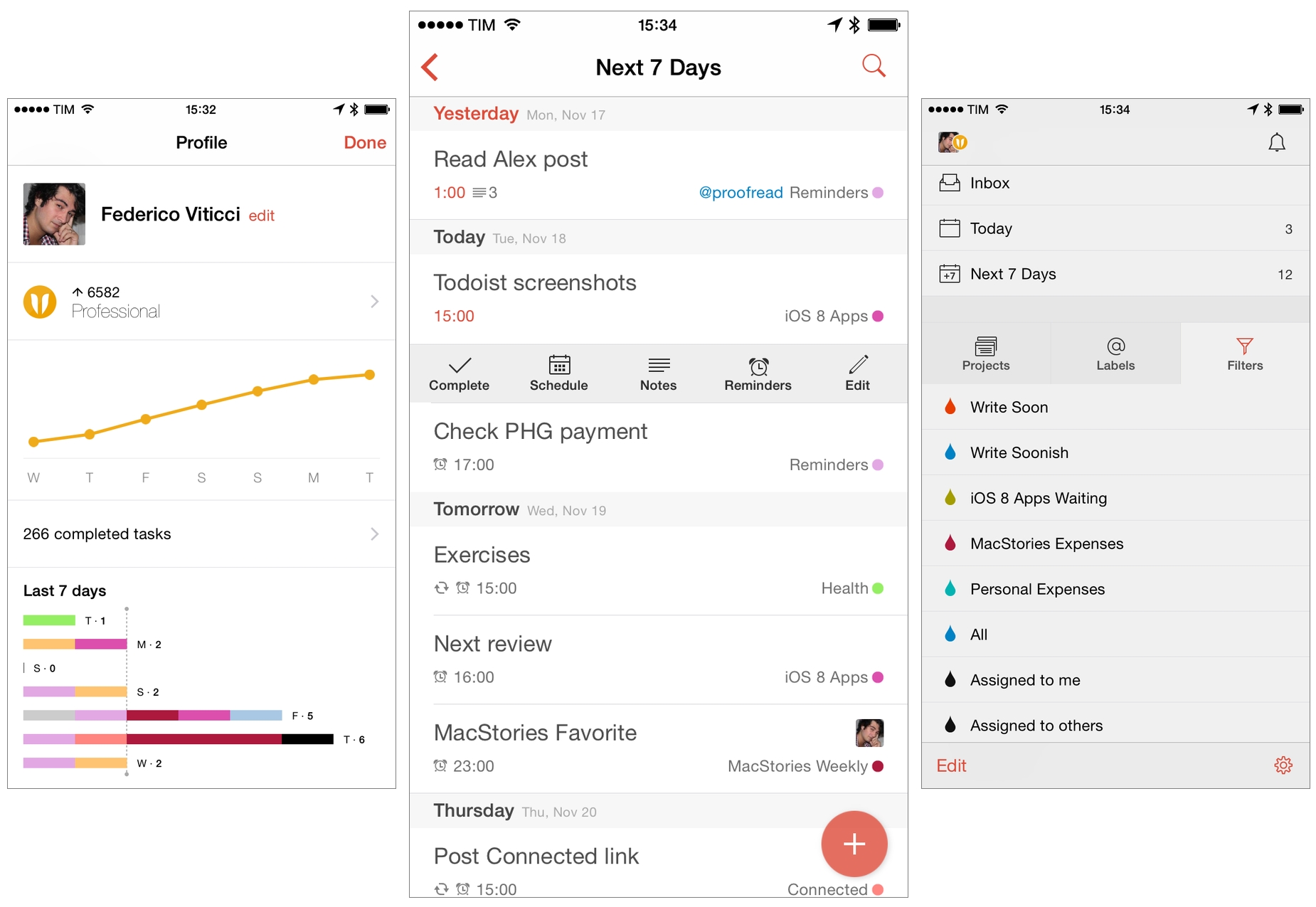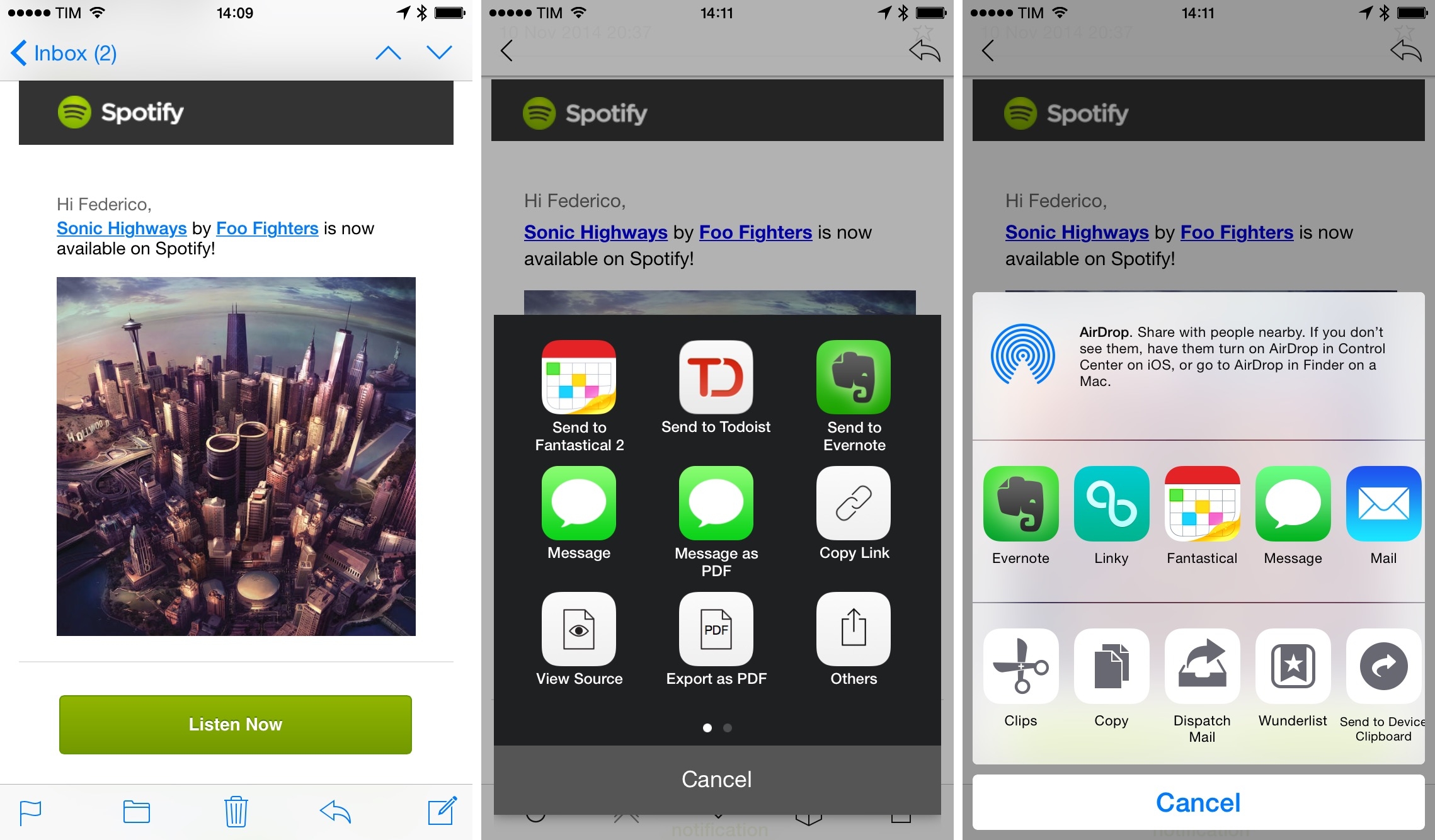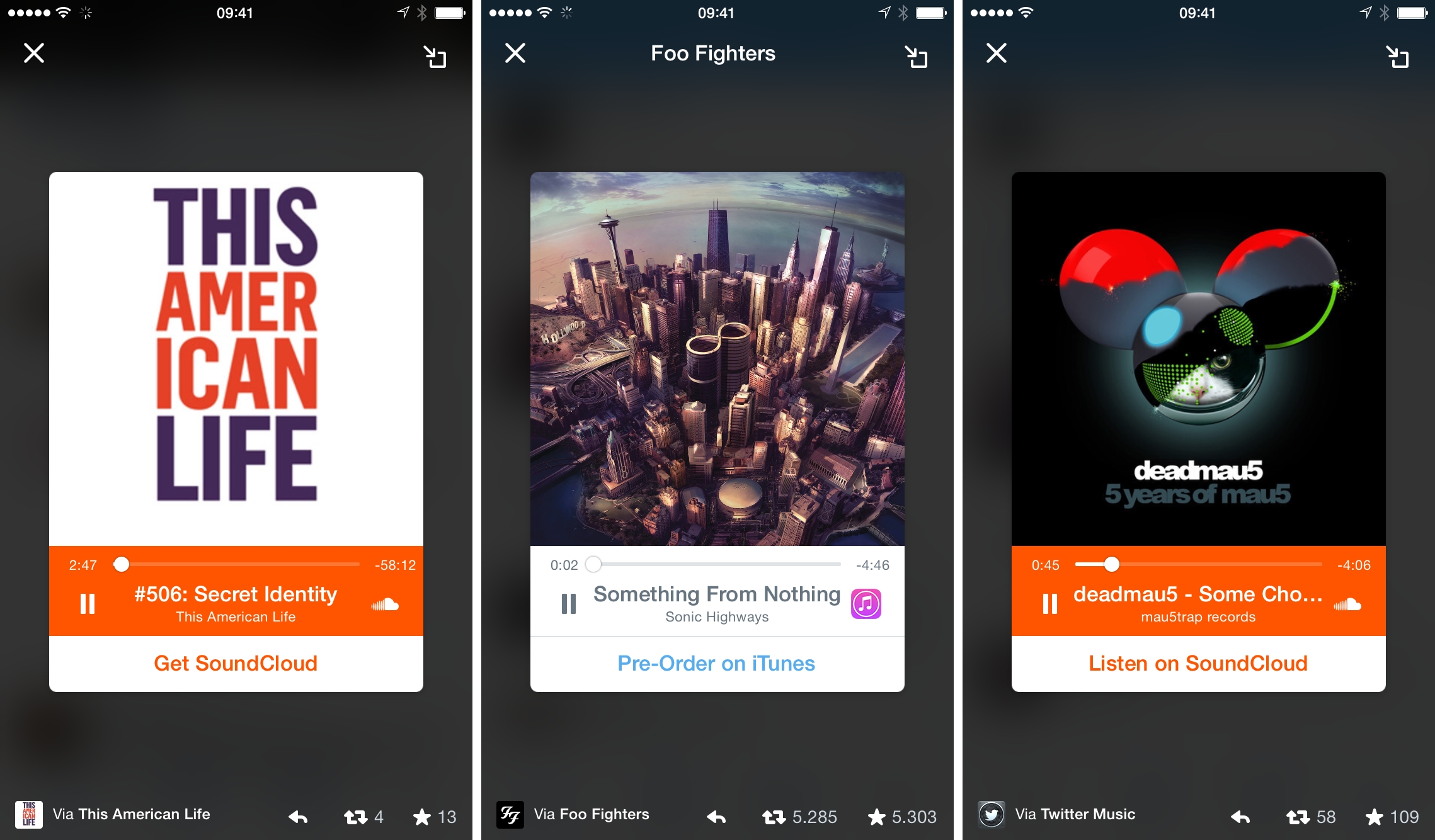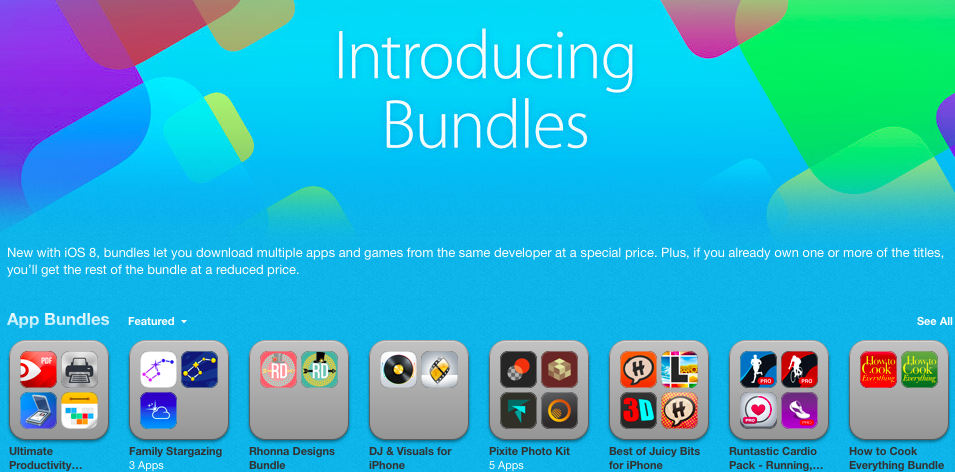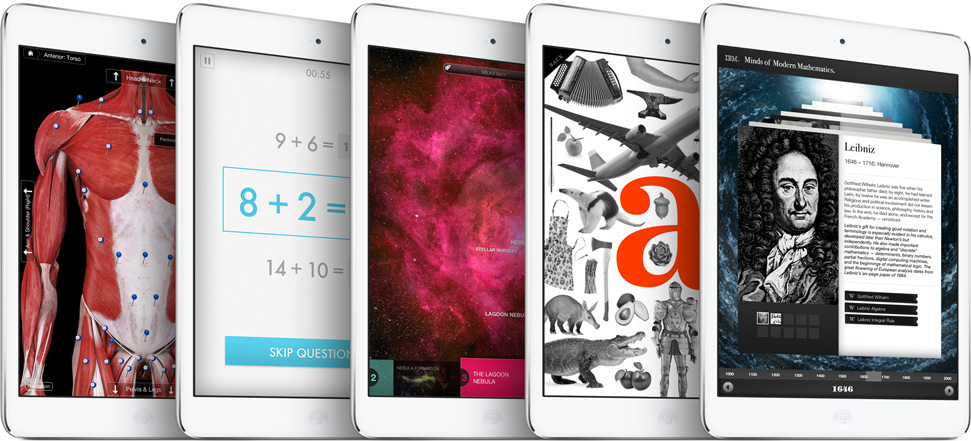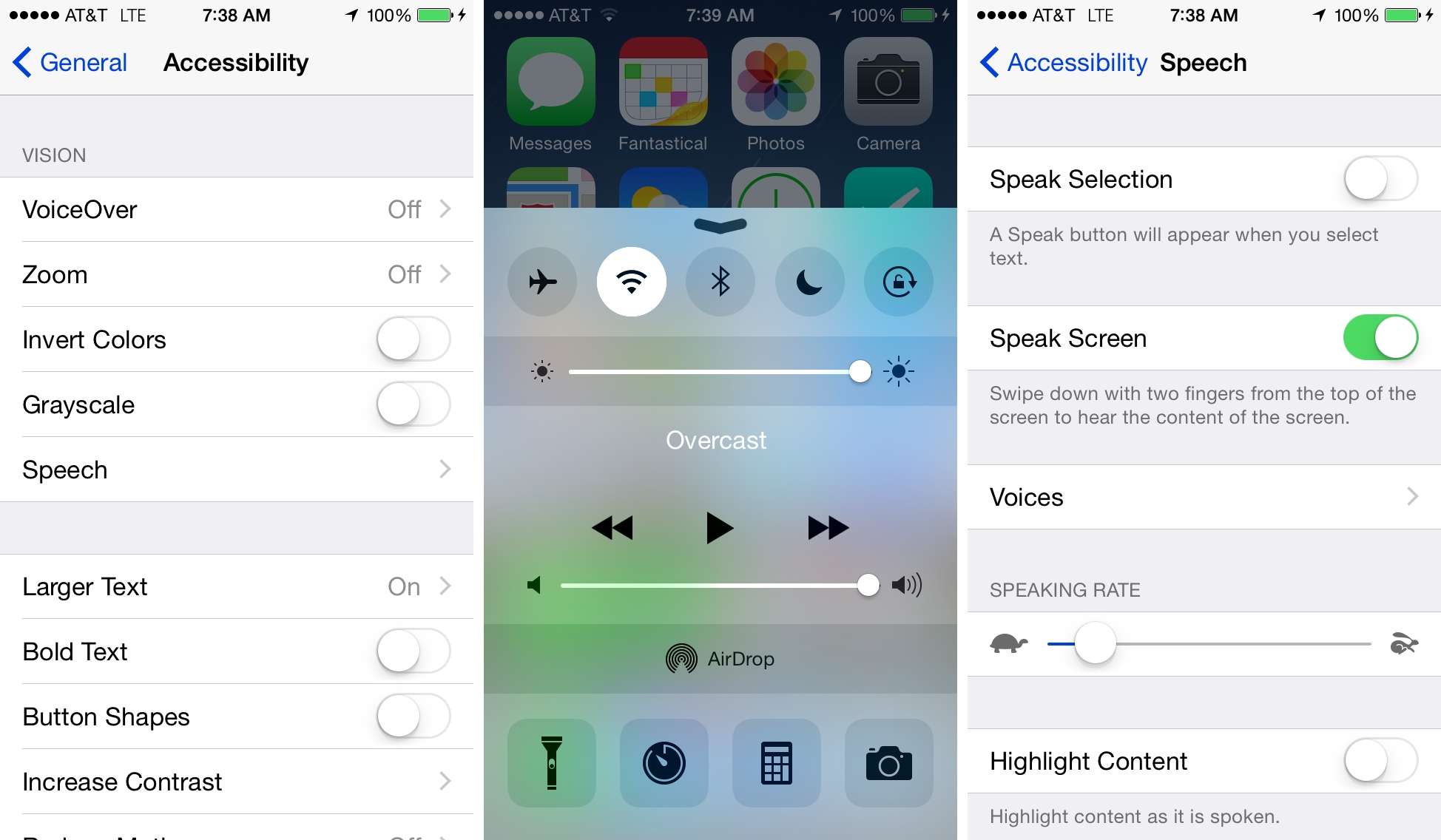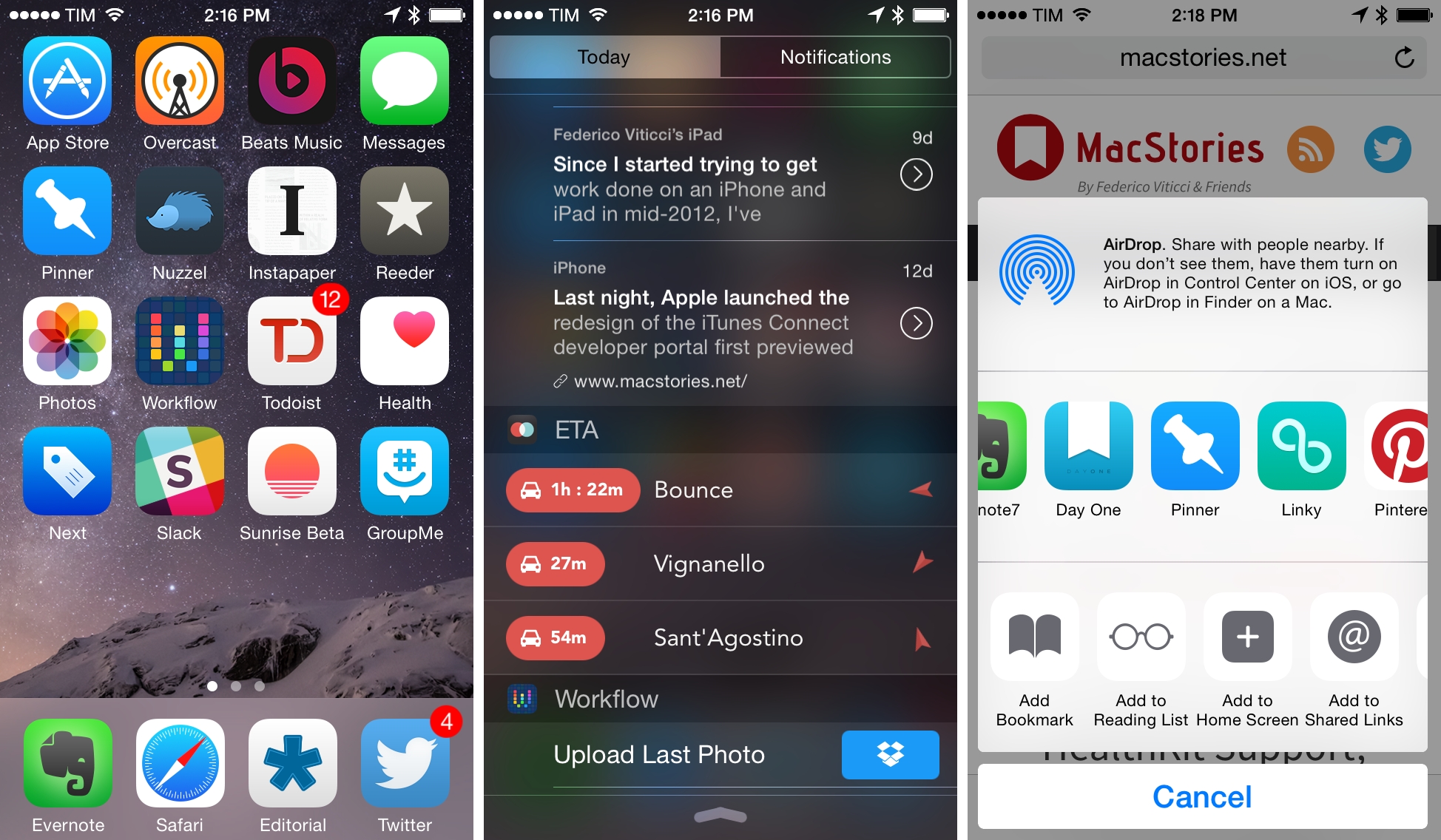I use a lot of apps, but there are only a few that I open every single day, and over the past few months Snapchat has become one of those elite few for me. If you told me this back in January, I wouldn’t have believed you and probably would have laughed at the idea too. Why the drastic change in opinion of Snapchat? Well, I eventually signed up when a few of my friends convinced me to, but my usage really skyrocketed with the launch of their (relatively) recent feature called ‘Our Story’. But first, an explanation of Snapchat and how it has rapidly evolved into a number of different features.
Posts in stories
Snapchat’s ‘Our Story’ Events Are a Captivating Experiment
Why I Left iCloud Reminders for Todoist
For over two years, I used Apple’s Reminders as my task management app. Contrary to expectations from Internet friends and colleagues who swore by more complex solutions, I was fine with Reminders and I didn’t need anything more.
iOS 8, Email, and Extensions
One of my biggest frustrations with iOS 8 so far is the lack of extension support in Apple’s Mail app. As I wrote in iOS 8 Changed How I Work on My iPhone and iPad:
I’m disappointed to see a lack of extension support in Apple’s own apps, and particurlarly in Mail. It just makes sense, in my opinion, to be able to turn messages into tasks or archived documents, but Apple hasn’t integrated extensions with Mail yet.
My feelings haven’t changed since September and, in fact, Mail’s non-existent sharing capabilities have been exacerbated by my move towards a more iPad-centric workflow after upgrading to an iPad Air 2. I’ve been working from my iPad Air 2 on a daily basis for the past two weeks, and the friction in Apple’s Mail app has led me to use other email clients simply because they came up with their own implementation of action and share extensions for email messages.
iOS 8, Accessibility, and Third-Party Keyboards
In the overview I wrote for MacStories of the new Accessibility features of iOS 8, I said this about the operating system’s support for third-party keyboards:
This topic (as well as QuickType) is worthy of its own standalone article, but the accessibility ramifications of iOS 8’s third party keyboard API are potentially huge for those with special needs.
Four months later, that statement still holds true.
Over the past few weeks, I’ve been using two such keyboards — Fleksy and Keedogo — in an effort to not only simply test-drive a new feature, but also to gauge the accessibility merits of the keyboards. While I’ve found Fleksy and Keedogo to be fine in terms of accessibility, even in the midst of testing them, I’ve found myself going back to Apple’s stock keyboard. In the end, that I don’t use any third-party keyboard as a replacement for the default one on my iOS devices is no fault of either developer — it’s Apple’s.
Before explaining why it’s Apple’s fault, though, it’s important to discuss the virtues of Fleksy and Keedogo.
The Utility of Twitter Cards
The Audio Card is the latest entry in Twitter’s line-up of interactive cards. The feature was announced earlier this week by Twitter, with SoundCloud being the first partner:
The world’s most influential musicians and media producers already share unique audio content through Twitter every day. Today we’re introducing a new way for you to experience audio directly on Twitter.
With a single tap, the Twitter Audio Card lets you discover and listen to audio directly in your timeline on both iOS and Android devices. Throughout your listening experience, you can dock the Audio Card and keep listening as you continue to browse inside the Twitter app.
Musicians, podcasters, and other producers of audio content are on board with SoundCloud cards that can be played without leaving the Twitter app. In a separate blog post, Twitter also announced compatibility with iTunes Music:
Now, when you listen to music from select iTunes artists, it’ll only take a few taps to pre-order unreleased music and purchase your favorite songs directly from iTunes.
Foo Fighters are already using the Audio card to promote their new song, Something From Nothing.
One Week After iOS 8, Developers Comment on App Bundles
With the release of iOS 8 last week, Apple launched app bundles, a new way for users to buy up to 10 apps from the same developer with a single purchase at a discounted price.
Officially introduced at WWDC 2014 as a feature of the new iTunes Connect, bundles mark a significant change for Apple’s App Store since its opening in 2008: for the first time, developers can market their apps through discounts that can be configured in iTunes Connect rather than organize independent promotions based on price drops; from a user’s perspective, app bundles are reminiscent of Apple’s Complete My Album feature of the iTunes Store.
Shortly after the debut of iOS 8, Apple created a special App Store page showcasing popular bundles for apps, games, and apps for kids. Bundles are easy to spot on the App Store: like folders on iOS, a bundle’s icon is a container of apps inside the bundle, showing a preview of the first four apps included in the bundle; a special badge indicates the number of apps in the bundle; and, only paid apps from the same developer can be part of a bundle – you won’t be able to find games from EA and Ubisoft or apps from Readdle and Runtastic in the same bundle. Since last week, Apple has been heavily promoting productivity bundles from Readdle and Pixite, games from Square Enix and Disney, and apps by Toca Boca and Diptic.
Following the launch of bundles, I’ve been talking to several developers who collected some of their apps in bundles, gauging their reactions to this new feature of the iOS 8 App Store and their thoughts on Apple’s promotional push so far.
Learning and Relearning iOS
In the school where I teach, we are now into our fifth school year using iPad in the classroom. We have students from 5-18 using the device and using it very differently according to their age and educational needs. We have found it to be a substantial addition to the life and work of our school and a major enhancement to the educational process.
Unlike many schools, we don’t focus on “delivering content” with the iPad. We don’t use electronic textbooks and we don’t buy a lot of curriculum materials in the form of apps. Instead, we view the iPad as a tool for creativity in the classroom. We think of apps not as replacements for books but as a new kind of pen, pencil, ruler, paintbrush, camera, music studio, art material, scientific log book, homework diary, writing pad and movie editing suite.
We have used every version of iOS since iOS 3.2 on the original iPad. Many releases have brought substantial improvements in our daily use of the iPad – for example multitasking in iOS 4 or AirPlay Mirroring in iOS 5 on the iPad 2. I think we are on course for the most substantial change to iOS since it shipped on the iPad this year.
iOS 8 brings many deep changes and improvements to the platform that we know and love to use in our school. I want to highlight a few of them, but it’s important to remember that sometimes the biggest wins are in the fixes to the small daily annoyances.
Looking at Accessibility in iOS 8
Soon after WWDC ended in June, I wrote a piece for MacStories in which I briefly summarized all the new features Apple added to Accessibility in iOS 8. Since then, I’ve spent a lot of time with the iOS 8 beta builds over the summer, and have found several features and little touches – even some things that aren’t specific to Accessibility – that merit a more detailed look. What follows are my personal impressions of such.
iOS 8 Changed How I Work on My iPhone and iPad
When I reviewed iOS 7 last year, I took a different approach and tried to consider Apple’s redesigned OS from the perspective of someone who uses iPhones and iPads for work and personal tasks on a daily basis. I noted that a new structure enabled developers to make more powerful apps, and I concluded hoping that Apple would “consider revamping interoperability and communication between apps in the future”.
With today’s release of iOS 8, Apple isn’t merely improving upon iOS 7 with minor app updates and feature additions. They’re also not backtracking on the design language launched last year, which has been refined and optimized with subtle tweaks, but not fundamentally changed since its debut in June 2013.
Apple is reinventing iOS. The way apps communicate with each other and exchange functionality through extensions. How status awareness is being brought to iPhones, iPads, and Macs with Handoff and Continuity. Swift and TestFlight, giving developers new tools to build and test their apps. Custom keyboards and interactive notifications.
There are hundreds of new features in iOS 8 and the ecosystem surrounding it that signal a far-reaching reimagination of what iOS apps should be capable of, the extent of user customization on an iPhone and iPad, or the amount of usage data that app developers can collect to craft better software.
Seven years into iOS, a new beginning is afoot for Apple’s mobile OS, and, months from now, there will still be plenty to discuss. But, today, I want to elaborate on my experience with iOS 8 in a story that can be summed up with:
iOS 8 has completely changed how I work on my iPhone and iPad.



